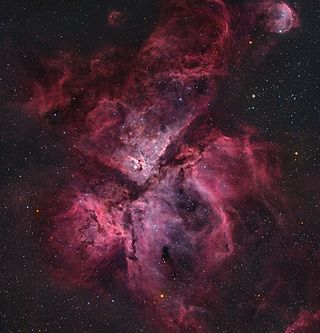
The Carina Nebula or Eta Carinae Nebula is a large, complex area of bright and dark nebulosity in the constellation Carina, located in the Carina–Sagittarius Arm of the Milky Way galaxy. The nebula is approximately 8,500 light-years (2,600 pc) from Earth.

p Carinae is the Bayer designation of a star in the southern constellation of Carina. It has the variable star designation PP Carinae and, at an apparent visual magnitude of +3.3, is readily visible to the naked eye from the southern hemisphere. From the observed parallax shift of this star as the Earth orbits the Sun, its distance can be estimated as roughly 480 light-years with a 6% margin of error. It is considered to be a member of the open cluster IC 2602 although it lies well outside the core visible group of stars.
HD 90853 is a single star in the southern constellation Carina. It has the Bayer designation s Carinae, while HD 98053 is the identifier from the Henry Draper catalogue. This is a variable star with an apparent visual magnitude that ranges from 3.36 down to 3.51, and thus is bright enough to be visible to the naked eye. It is located at a distance of approximately 1,340 light-years from the Sun based on parallax, and has an absolute magnitude of −4.44. The star is drifting further away with a radial velocity of +9 km/s.

V382 Carinae, also known as x Carinae, is a yellow hypergiant in the constellation Carina. It is a G-type star with a mean apparent magnitude of +3.93, and a variable star of low amplitude.

V520 Carinae is a single star in the southern constellation of Carina. It has the Bayer designation w Carinae, while V520 Carinae is a variable star designation. The star has an orange hue and is faintly visible to the naked eye with an apparent visual magnitude that fluctuates around +4.58. It is located at a distance of approximately 1,140 light years from the Sun based on parallax, and it is drifting further away with a radial velocity of +9 km/s. It is a candidate member of the IC 2391 moving group of co-moving stars.
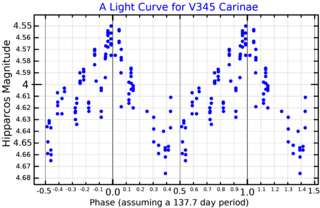
V345 Carinae is a star in the constellation Carina. It has the Bayer designation E Carinae; V345 Carinae is the variable star designation. The star has a blue-white hue and is faintly visible to the naked eye with an apparent visual magnitude that fluctuates around +4.66. Its actual brightness varies from magnitude +4.67 to +4.78 with a period of 137.7 days. Based on parallax measurements, it is located at a distance of approximately 1,010 light years from the Sun. It is drifting further away with a radial velocity of around +19 km/s.

HD 92063 is a single star in the southern constellation of Carina. It has the Bayer designation t1 Carinae, while HD 92063 is the star's identifier from the Henry Draper Catalogue. This is a suspected variable star and is visible to the naked eye with an apparent visual magnitude of 5.08. The star is located at a distance of approximately 246 light years from the Sun based on parallax, but is drifting closer with a radial velocity of −10 km/s. Although it appears at the edge of the Carina Nebula, it is much closer than the nebula. It is also not considered a member of the nearby Alessi 5 open cluster of stars.

A yellow hypergiant (YHG) is a massive star with an extended atmosphere, a spectral class from A to K, and, starting with an initial mass of about 20–60 solar masses, has lost as much as half that mass. They are amongst the most visually luminous stars, with absolute magnitude (MV) around −9, but also one of the rarest, with just 20 known in the Milky Way and six of those in just a single cluster. They are sometimes referred to as cool hypergiants in comparison with O- and B-type stars, and sometimes as warm hypergiants in comparison with red supergiants.
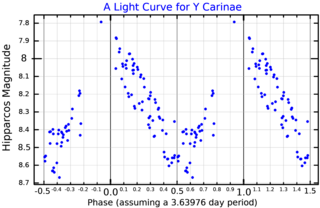
Y Carinae is a Classical Cepheid variable, a type of variable star, in the constellation Carina. Its apparent magnitude varies from 7.53 to 8.48.

AG Carinae is a star in the constellation Carina. It is classified as a luminous blue variable (LBV) and is one of the most luminous stars in the Milky Way. The great distance and intervening dust mean that the star is not usually visible to the naked eye; its apparent brightness varies erratically between magnitude 5.7 and 9.0.

HR Carinae is a luminous blue variable star located in the constellation Carina. It is surrounded by a vast nebula of ejected nuclear-processed material because this star has a multiple shell expanding atmosphere. This star is among the most luminous stars in the Milky Way. It has very broad emission wings on the Balmer lines, reminiscent from the broad lines observed in the spectra of O and Wolf–Rayet stars. A distance of 5 kpc and a bolometric magnitude of −9.4 put HR Car among the most luminous stars of the galaxy.

A hypergiant (luminosity class 0 or Ia+) is a very rare type of star that has an extremely high luminosity, mass, size and mass loss because of its extreme stellar winds. The term hypergiant is defined as luminosity class 0 (zero) in the MKK system. However, this is rarely seen in literature or in published spectral classifications, except for specific well-defined groups such as the yellow hypergiants, RSG (red supergiants), or blue B(e) supergiants with emission spectra. More commonly, hypergiants are classed as Ia-0 or Ia+, but red supergiants are rarely assigned these spectral classifications. Astronomers are interested in these stars because they relate to understanding stellar evolution, especially star formation, stability, and their expected demise as supernovae.

55 Cygni is a blue supergiant star in the constellation Cygnus. It is thought to be a member of the Cygnus OB7 stellar association at about 2,700 light years.

V518 Carinae is a naked-eye variable star in the constellation Carina. It is a member of the bright open cluster IC 2602 near the Carina Nebula.
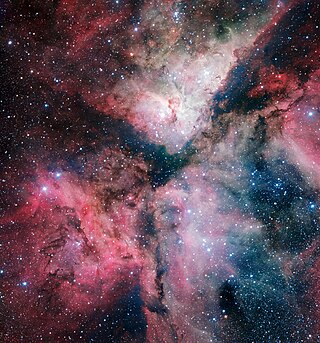
WR 24 is a Wolf-Rayet star in the constellation Carina. It is one of the most luminous stars known. At the edge of naked eye visibility it is also one of the brightest Wolf Rayet stars in the sky.
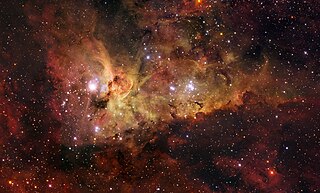
Trumpler 16 is a massive open cluster that is home to some of the most luminous stars in the Milky Way galaxy. It is situated within the Carina Nebula complex in the Carina–Sagittarius Arm, located approximately 9,270 ly (2,842 pc) from Earth. The cluster has one star visible to the naked eye from the tropics southward, Eta Carinae.

CK Carinae is a variable star in the constellation Carina, the keel of Argo Navis. It is a member of the star association Carina OB1-D, at a distance of around 2,300 parsecs or 7,500 light years.

V528 Carinae is a variable star in the constellation Carina.
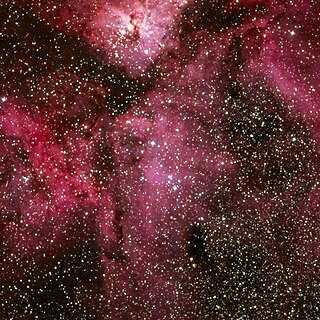
Collinder 228 is an open cluster within the southern part of the Carina Nebula NGC 3372, about 25' south of η Carinae. It is probably composed of stars which recently formed from the material in the nebula. QZ Carinae is the brightest member of Collinder 228 with an apparent magnitude between 6.16 and 6.49.

















